#tubular blossoms
Explore tagged Tumblr posts
Text
TOTALLY TUBULAR...



(c) three photos by @xlntwtch2 ... pics taken during summer 2024
interestingly weird, huh?
top to bottom:
flowers on an aloe succulent
an odd flowering plant we don't know at all
red hot poker - young flowers on grassy plant
#nature#photography#photographers on tumblr#original photography#flowers#tube flowers#tubular blossoms#three photos of flowering plants#xlntwtch2
34 notes
·
View notes
Text
thinking of an isekaied reader and a yandere noble boy...
(gn reader x male noble yandere)
part 1 / part 2 / part 3 / part 4 / part 5
tw: manipulative behavior, thats about it though

you stared at the honeysuckles climbing alongside the fence near the outskirts of your family's garden. as you continue examining them, it occurs to you that they seem to take on a vine-like shape, wrapping and constricting the fence. in front of the vines there are two smaller shrubs, also presumably honeysuckles.
as you stand there awkwardly lost in thought, oliver begins speaking. he takes one step forward as his eyes shift between the shrub and the vines, "there are three types of honeysuckle: shrubs, bushes, and vines."
he takes a careful step between the two shrubs and strides towards the vines, reaching a gentle hand out and caressing a pale pink, almost white blossom in his fingers. "while their flowers are pretty, in some places they can be invasive. they can block out sunlight, making it impossible for other plants to grow."
he's standing in front of you, so it's hard to gauge his expression. his voice is calm and serene, almost reverent as he speaks about the flowers.
"the pale pink flowers on the vines are likely common honeysuckle vines. while the pink tubular flowers on the shrub indicate that those are likely tatarian honeysuckles."
he slowly turns away from the vines as your eyes focus on his hand caressing the flower. in one swift motion he uses his left hand to pluck it off the vine, then turns towards the shrub. he's still standing in the same spot, but as he turns you can finally see his face.
his expression is cold, almost apathetic as he looks at the flowers. with how he sounded you would have expected him to at least be smiling. his dark brown eyes quickly meet yours before he looks at the shrub. he crouches down, still holding the pale pink flower in his left hand. his right hand reaches out gently to a darker pink blossom belonging to the shrub.
"chances are, some gardener got careless and either decided to plant these because they didn't feel like planting something higher maintenance... or they simply," he rips the flower off, "didn't notice that an invasive flower slipped into the garden..."
as he holds the pale pink flower in his left hand and a dark pink flower in his right, he finally shifts his body to face you and meets your eyes. his expression shifts to a much softer one as he looks at you, "i don't know what happened to you, but what i do know is that you are definitely acting different."
your blood runs cold, surprised he decided to bring this up again. you stand there for a second, about to reply before he smiles gently at you, catching you off guard.
"i know you have been having trouble with your memory, my love." he says, "it just..."
"it makes me so sad when you look at me like that... like..." you notice his eyes look sad, almost like he's tearing up as he speaks, "when you look at me like you don't know who i am, or what we were, or how much i love you."
he moves his hands to yours, gently taking your left palm and bringing it between the two of you. then he slowly holds up the two flowers in each of his hands, "obviously this isn't your fault, but..." he pauses, "i don't want to make you hate me by going too far too fast."
"so, i wanted to ask," he moves the dark pink tatarian honeysuckle towards you, "do you wish to resume our relationship, as passionate yet secret lovers," he moves the pale pink common honeysuckle flower closer to you, "or do you want to start over, from the moment where i got down on my knees and told you how much i love you for the first time?"
he looks at you gently, waiting for you to take one of the flowers in your hand, "i don't want to overwhelm you, darling, but please..."
"i just can't live without your love any longer. please, love, even if you don't remember, won't you fall in love with me again?"
a/n: (this is the part where my indecisiveness starts showing)
anyways !! would you like to "resume the relationship", start over, or say no to both (secret option he's not gonna say but i will)
#red pill or blue pill?#nah we got light pink or dark pink flower here#the matrix at home be like#ariadne's writing - 🩷#ariadne's ocs - oliver northwood#yandere#yandere x reader#yandere oc#yandere oc x reader#yandere x darling#yandere imagines#yandere scenarios#male yandere#soft yandere
454 notes
·
View notes
Text
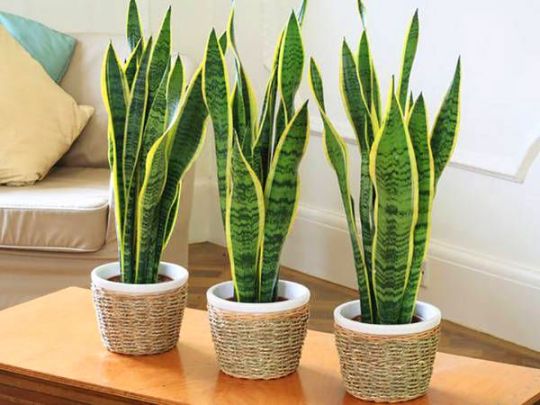
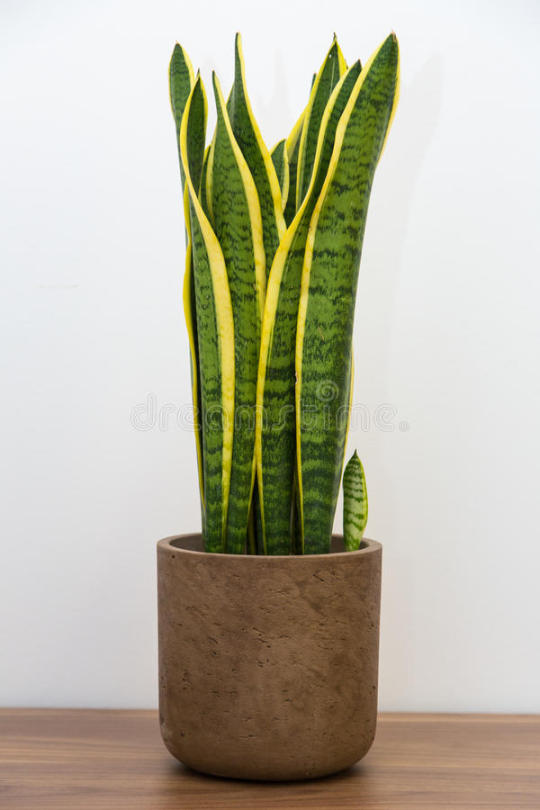
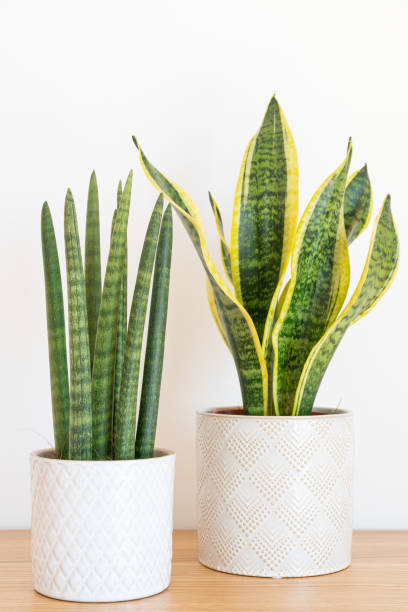
Snake Plant Sansevieria (also called Snake Plant) Dracaena trifasciata ‘Laurentii’ Adored by generations of houseplant owners for its ease of growth, this variety won the Award of Garden Merit from the Royal Horticultural Society of the UK in 1993 and is still popular today. This species is native to areas of Western Africa and is often enjoyed in planters in decks and patios in addition to its common use as a houseplant. It’s relatively slow-growing, especially in low-light conditions (which it tolerates well). Its vertical growth makes is perfect for small spaces, as well as contemporary/modern decorating schemes. One of the most forgiving and durable indoor plants you can grow, Laurentii Snake Plant (botanically Dracaena trifasciata ‘Laurentii’, formerly Sansevieria trifasciata ‘Laurentii’) features mint-green leaves banded with horizontal dark green stripes and golden-yellow leaf edges. It typically grows 24 to 36 inches tall indoors. It is grown and shipped fresh from our farm direct to your front door. Easy to grow houseplant and perfect for houseplant beginners. Variegated foliage adds a distinctive look to your home all year long. Excellent for homes and offices.
it’s among the easiest to grow and care for. So much so that it doesn’t need sunlight, the artificial light found in the typical office is perfectly fine. It can go weeks without watering, and it tolerates low levels of humidity.
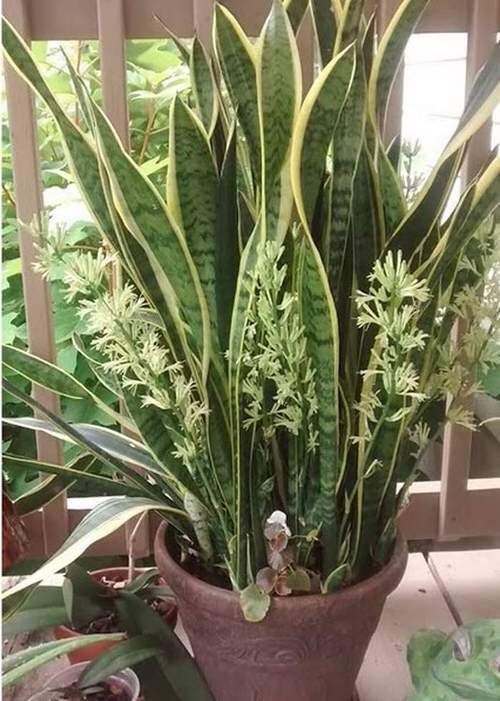
You might have never seen a snake plant flower as it’s quite rare. However, it is possible for you to experience it if you follow the right steps. Let’s have a look at some tricks on How to Get a Snake Plant to Bloom!
How to Get a Snake Plant to Bloom (Highly Fragrant & Rare)
youtube
You might have never seen a snake plant flower as it’s quite rare. However, it is possible for you to experience it if you follow the right steps. Let’s have a look at some tricks on How to Get a Snake Plant to Bloom!
Do Snake Plants Flower? The straight answer to the question is, Yes! They do! This happens once annually, usually during spring or summer, if the conditions meet. However, it is still extremely uncommon but possible. You also have to bear the fact in mind that if you have grown Sansevieria trifasciata ‘Hahnii,’ then it won’t bloom, no matter what.
Snake Plant Flower Appearance Snake plant flowers grow around tall spikes or stalks. The stalks grow up to several inches or feet tall and are full of small, lily, or honeysuckle-like, tubular, cream, green, or white narrow-petaled clusters of blooms–all this depends on the type of snake plant. According to the variety, some cultivars have white with a hint of mauve or lavender. Some species show off bright red blossoms. Some varieties of mother-in-law’s tongue do not have a flower stalk, and they directly blossom from the base in huge clusters.
Snake Plant Flower Smell The snake plant flowers are highly fragrant and emit a spicy vanilla-like scent that you can’t compare with anything. The blooms also produce sweet-scented nectar, so much in fact that it can drip down the stalk! Flowers close in the daytime and open up during the night. The fragrance becomes very strong after it gets dark.
How to Get a Snake Plant to Bloom? There’s no guarantee that the snake plant you have will bloom. However, there are certain factors that might help it flower. The best way to make snake plants bloom is to keep them in a root-bound stage and expose them to a lot of sunlight. Most people keep this in extremely low light or shade, which will prevent the plant from flowering. Keeping them outdoors or near a window that receives some direct light can induce flowering. When the plant is watered less and is kept in good light, it grows quickly, thereby filling up the pot in no time. When the roots have no more space to grow and the pot gets filled with them, the plant flowers to propagate itself. Generally, new and young snake plants do not flower. You will have more chances of flowering with an aged specimen. Keeping the plant in a slightly stressed state, along with low fertilization, can also trick it into blooming flowers. Avoid keeping the plant in shade for a longer duration of time. Always make sure that the plant gets a minimum of 3-4 hours of direct sun each day. The best bet is to keep it near an east-facing window. Do not overwater the plant in any case.
The Bottom Line These pointers will certainly help it bloom, but these serve no surety that doing this will make every snake plant flower! It seems certain conditions force this amazing houseplant to bloom, or you can say these plants have a mind of their own when it comes to blooming.
3 notes
·
View notes
Text
On Canvas: FOXGLOVE
In the secret corners of enchanted forests, where sunlight filters through ancient trees, Digitalis purpurea, the Foxglove, conceals its potent mysteries. This bewitching plant, with its tall, elegant spires of tubular blossoms, has woven a tapestry of legends throughout the annals of botanical lore.
Foxglove is no mere flower; it is a sentinel of both danger and healing, its very name a testament to duality. In the language of the woods, it is whispered that foxes wear these petals as gloves to silence their pawsteps as they navigate the realms unseen. Legend has it that fairies, those mischievous guardians of the earth, use the flowers' bell-shaped blooms as hats, granting them access to realms beyond the human gaze.
Yet, Foxglove is not to be trifled with, for its delicate beauty conceals a potent toxin, digitalin, capable of bringing both ecstasy and peril. In the hands of skilled herbalists, it has been harnessed as a medicine, mending hearts and alleviating suffering. But one misstep, one careless touch, and it transforms into a poison that ensnares the unsuspecting.
This plant, a bridge between realms, beckons to those who dare to traverse its treacherous path. To gaze upon its fiery-hued blossoms is to peer into the mystical unknown, where the boundaries of life and death blur. The Foxglove, with its enigmatic allure, continues to enchant, a symbol of the profound mysteries that nature herself guards with both peril and wonder.
.: 100% cotton fabric (400gsm)
.: Horizontal, vertical and square options available
.: Closed MDF backing
.: Built with a patented solid support face
.: High image quality and detail
.: NB! For indoor use only #foxglove #foxgloveart #foxglovewallart #foxgloveflowerart #witchy #poisonousplants
#flowers#foxglove#foxgloveflowers#witchy#witchythings#divine art#divine feminine#beautiful#allure#nature#history#sacred plants#sacred geometry#the sacred feminine#sa
2 notes
·
View notes
Link
0 notes
Text

Fried Dandelions
Fried dandelions are a local favorite back in West Virginia, up in the Appalachian Mountains. This is my mom's recipe and consists of picking the largest dandelion flowers and leaving the entire stem behind, battering the flowers up and frying them in butter. They have a flavor similar to that of mushrooms and are delicious!
Ingredients
2 cups all-purpose flour
2 tablespoons seasoned salt
1 tablespoon ground black pepper
4 large eggs
80 unopened dandelion blossoms, stems removed
½ cup butter
Directions
Combine flour, seasoned salt, and pepper in a mixing bowl until evenly combined; set aside. Beat eggs in a mixing bowl, then stir in dandelion blossoms until completely coated.
Melt butter in a large skillet over medium heat. Remove half of the dandelions from egg mixture, and allow the excess egg to drip away. Toss in flour until completely coated, then remove and toss between your hands to allow excess flour to fall away. Cook coated dandelions in the melted butter until golden brown, stirring occasionally, about 5 minutes. Drain on a paper towel-lined plate. Repeat with the remaining dandelions.
Cook’s Note
To avoid a bitter taste, make sure the dandelion flowers you're picking have not been sprayed by dogs or pesticides.
Prepare the dandelion flowers ahead of time by submerging them in a bowl of room-temperature water with about 1 tablespoon salt added to the water. This rids the flowers of any insects that could be in the blossoms. Soak for about 10 minutes. Rinse the flowers in fresh water. Using a salad spinner works nicely to rinse and dry the dandelion flowers.
There is a variety of dandelion that has a thin solid stalk, and this is not the flower to use. Make sure the dandelions you pick have a tubular stalk.
As an option, canola or vegetable oil can be used to fry the dandelions, but the flavor will change accordingly.
Try using some other spices, like garlic powder, in seasoning to taste.
Editor's Notes:
The nutrition data for this recipe includes the full amount of the breading ingredients. The actual amount of the breading consumed will vary.
We have determined the nutritional value of oil for frying based on a retention value of 10% after cooking. The exact amount will vary depending on cooking time and temperature, ingredient density, and the specific type of oil used.
CR :: https://www.allrecipes.com/recipe/214172/fried-dandelions-appalachian-style/
1 note
·
View note
Text
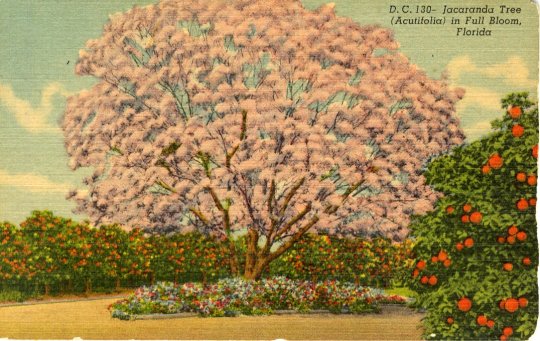
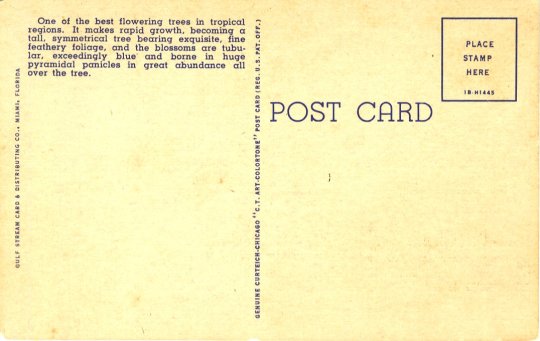
Jacaranda Tree (Acutifolia) in full bloom, Florida
One of the best flowering trees in tropical regions. It makes rapid growth, becoming a tall, symmetrical tree bearing exquisite fine feathery foliage, and the blossoms are tubular, exceedingly blue and borne in huge pyramidal panicles in great abundance all over the tree.
1 note
·
View note
Text
14 Gorgeous Perennial Bushes That Bloom All Summer
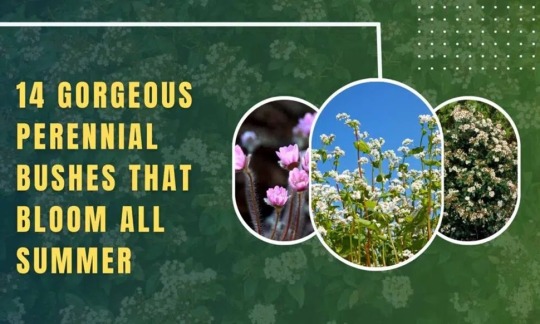
Title: 14 Stunning Perennial Bushes That Blossom Throughout Summer
Introduction: When it comes to creating a vibrant and lively garden, perennial bushes that bloom throughout the summer are indispensable. These plants not only add a splash of color but also offer continuous beauty without the need for frequent replanting. Whether you're a seasoned gardener or a novice enthusiast, incorporating these 14 stunning perennial bushes into your landscape can elevate your outdoor space to new heights of beauty and charm.
Rosa Rugosa (Beach Rose): Known for its resilience and fragrant blooms, the Rosa Rugosa is a classic choice for any garden. With its deep green foliage and vibrant pink, white, or red flowers, this bush adds both color and fragrance to your outdoor space.
Lavender: Lavender is not just a delight for the eyes but also for the senses with its soothing aroma. These bushes produce spikes of purple flowers that attract pollinators while adding a touch of elegance to your garden.
Hydrangea: Hydrangeas are renowned for their large, showy blooms that come in an array of colors ranging from pink and blue to white and purple. With proper care, these bushes can bloom prolifically throughout the summer months.
Butterfly Bush (Buddleia): As the name suggests, the Butterfly Bush is a magnet for butterflies and other pollinators. Its long spikes of fragrant flowers come in various shades, including purple, pink, white, and yellow, making it a colorful addition to any garden.
Coneflower (Echinacea): Coneflowers are not only beautiful but also beneficial for attracting bees and butterflies. Their daisy-like blooms in shades of pink, purple, and white add a cheerful charm to gardens, and they're relatively low maintenance.
Russian Sage: With its silvery foliage and delicate lavender-blue flowers, Russian Sage adds a touch of airiness and elegance to garden borders. It's drought-tolerant and blooms profusely throughout the summer.
Coreopsis (Tickseed): Coreopsis is prized for its daisy-like flowers that come in shades of yellow, orange, and red. These cheerful blooms are not only attractive to pollinators but also make excellent cut flowers for arrangements.
Japanese Spirea: Japanese Spirea is a versatile shrub with cascading clusters of flowers that bloom from late spring to summer. Available in various cultivars, it offers options in flower color, foliage, and size, catering to different garden aesthetics.
Salvia: Salvia, with its tall spikes of colorful flowers, is a favorite among gardeners for its long blooming period and low maintenance requirements. From vibrant blues and purples to soft pinks and whites, there's a salvia variety for every garden.
Daylily: Daylilies are prized for their vibrant blooms that last only a day but are produced in abundance throughout the summer. Available in a wide range of colors and patterns, these hardy perennials are a staple in many gardens.
Weigela: Weigela bushes are cherished for their bell-shaped flowers that attract hummingbirds and butterflies. With their arching branches and colorful blooms in shades of pink, red, and white, they bring a touch of charm to any landscape.
Shasta Daisy: Shasta Daisies are classic perennials known for their large, white, daisy-like flowers with sunny yellow centers. These cheerful blooms brighten up gardens and make excellent cut flowers for bouquets and arrangements.
Penstemon (Beardtongue): Penstemons are valued for their tubular flowers that come in an array of colors, including shades of pink, purple, blue, and red. These versatile perennials attract pollinators and thrive in sunny garden spots.
Creeping Phlox: Creeping Phlox is prized for its colorful carpet of flowers that cascade over walls, rock gardens, and borders. Available in shades of pink, purple, blue, and white, it provides a stunning ground cover that blooms profusely in summer.
Conclusion: With their long-lasting blooms and low maintenance requirements, these 14 perennial bushes are sure to add beauty and charm to your garden throughout the summer months. Whether you prefer vibrant colors, delicate fragrances, or attracting pollinators, there's a perennial bush on this list to suit every garden style and preference. So, roll up your sleeves, dig in the dirt, and watch as your garden comes alive with color and life all summer long.
0 notes
Text
Introduction: Kanakambaram, scientifically known as Crossandra infundibuliformis, is a captivating flowering plant that hails from the Acanthaceae family. Revered for its vibrant blossoms and lush foliage, Kanakambaram is celebrated not only for its ornamental value but also for its cultural significance in various parts of the world, particularly in India.
Botanical Characteristics: Native to India and other parts of Southeast Asia, the Kanakambaram plant is a perennial evergreen shrub that thrives in warm and tropical climates. It features glossy, lance-shaped leaves and produces clusters of tubular flowers that bloom in hues ranging from fiery orange and yellow to deep red. The flowers emerge throughout the year, adding a splash of color to gardens, landscapes, and indoor spaces.
Cultural Significance: In Indian culture, the Kanakambaram holds special significance, particularly in South Indian traditions. It is commonly used in religious ceremonies, festivals, and rituals, symbolizing auspiciousness, prosperity, and devotion. The vibrant blooms of Kanakambaram are often offered to Hindu deities, especially to Goddess Lakshmi, the goddess of wealth and prosperity, during prayers and rituals seeking blessings for abundance and prosperity.
Moreover, Kanakambaram flowers are also used in traditional Indian weddings and decorations, adorning bridal hairdos, garlands, and ceremonial spaces as a symbol of beauty, happiness, and marital bliss.
0 notes
Text
Blooms of the Southwest: Exploring the Floral Tapestry of El Paso
Introduction:
flowers el paso, nestled in the heart of the Chihuahuan Desert, may be known for its arid landscapes and rugged beauty, but the city is also home to a vibrant array of flowers that add color and life to its surroundings. From native desert blooms to carefully cultivated gardens, El Paso showcases a diverse floral tapestry. This article explores the enchanting world of flowers in El Paso, celebrating the unique flora that graces this southwestern gem.
Desert Blooms:
Yuccas and Agaves: The iconic yuccas and agaves are quintessential symbols of the Chihuahuan Desert. El Paso's landscape is adorned with these hardy succulents, their tall flower spikes reaching towards the arid sky. When in bloom, these plants showcase stunning clusters of white or cream-colored flowers, adding an ethereal touch to the desert scenery.
Prickly Pear Cacti: The resilient prickly pear cacti, with their distinctive paddle-shaped pads, bloom with vibrant, yellow flowers in the spring. These blossoms attract pollinators and contribute bursts of color to El Paso's desert landscape.
Ocotillo: The ocotillo, known for its slender, spiny stems, produces vivid red tubular flowers at the tips during the blooming season. These striking flowers contrast against the blue desert sky, creating a visual spectacle.
Cultivated Gardens and Parks:
El Paso Municipal Rose Garden: Tucked away in the heart of flower shop el paso tx is the Municipal Rose Garden, a haven of fragrance and color. This beautifully landscaped garden boasts a diverse collection of roses, offering a delightful retreat for those seeking a tranquil and visually pleasing environment.
Chamizal National Memorial: Chamizal National Memorial features meticulously maintained gardens that showcase a variety of flowering plants. Visitors can enjoy the seasonal blooms while taking in the historical significance of the park.
Tom Mays Unit: The Tom Mays Unit of Franklin Mountains State Park offers nature enthusiasts the opportunity to witness the blooming wildflowers of the Chihuahuan Desert. Hiking trails lead through landscapes adorned with poppies, verbena, and other native blooms during the spring months.
Local Flower Festivals:
El Paso Spring Flower Fair: The El Paso Spring Flower Fair is an annual celebration of the region's blooming beauty. Local nurseries and gardeners showcase a myriad of flowers, plants, and gardening accessories. The event provides a platform for the community to appreciate and cultivate a love for gardening.
Flower-Filled Events: Various community events and festivals in El Paso feature flower-filled displays. From street markets to cultural celebrations, these events often incorporate vibrant floral arrangements, adding a touch of natural beauty to the festivities.
Preservation and Appreciation:
Conservation Efforts: flower shops in el paso tx recognizes the importance of preserving its native flora. Conservation efforts focus on protecting the delicate balance of the Chihuahuan Desert ecosystem and promoting sustainable landscaping practices.
Educational Programs: Educational programs and initiatives in El Paso aim to raise awareness about the significance of native plants and the role they play in maintaining the region's biodiversity. Workshops, guided tours, and community outreach programs encourage residents to appreciate and protect the local flora.
Conclusion:
flower delivery el paso tx tapestry, woven with the resilient blooms of the desert and carefully nurtured gardens, adds a distinctive charm to the city's landscape. From the vibrant hues of wildflowers to the delicate fragrance of roses, flowers in El Paso symbolize the beauty that can thrive in even the most arid environments. As the community embraces the unique flora of the region, El Paso continues to bloom with a natural grace that captivates both residents and visitors alike.
Source Url:- https://sites.google.com/view/northgatefloristscom5/home
0 notes
Text
0 notes
Text
Aster: The Star of the Garden
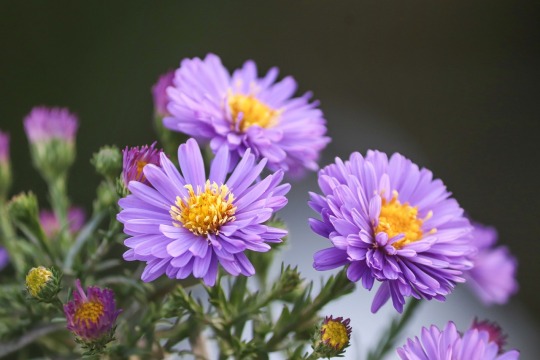
Asters, with their delicate and vibrant blossoms, are like stars in the garden. These dainty yet robust flowers belong to the Asteraceae family, and they have been cherished by gardeners and nature enthusiasts for centuries. Asters are renowned for their charming appearance, diverse colors, and their role as a late-season source of nectar for pollinators. Let's delve into the world of asters and explore the beauty and significance of these star-like blooms.
Appearance and Varieties: Asters are often characterized by their daisy-like flower heads, which consist of a central disc of tubular florets surrounded by ray florets that resemble petals. The range of colors is astonishing, from classic white and various shades of pink and purple to vibrant reds and blues. These stunning blooms come in various shapes and sizes, making them suitable for all types of gardens, from formal flower beds to wildflower meadows.
There are many aster species, but some of the most popular varieties include the New England Aster (Symphyotrichum novae-angliae), the Michaelmas Daisy (Aster amellus), and the New York Aster (Symphyotrichum novi-belgii). Each variety offers a unique beauty and character, providing gardeners with an array of options to choose from.
Cultural Significance: Asters hold cultural significance in various parts of the world. In ancient Greek, the name "aster" means star, which alludes to the shape of the flower head. The Greeks believed that asters were created from stardust when Virgo, the virgin goddess, wept, which is why they are often associated with purity and elegance.
In Victorian flower language, asters symbolize patience, daintiness, and remembrance. They were frequently used to convey messages of love, both romantic and platonic. In many cultures, asters are also associated with healing properties, and their leaves were used in traditional herbal remedies.
Ecological Importance: Asters play a vital role in supporting pollinators, particularly during the late summer and early autumn when many other nectar sources are scarce. Bees, butterflies, and other insects are drawn to the abundant nectar of asters, making them an essential part of the ecosystem. Gardeners often include asters in their designs to help maintain biodiversity and support declining pollinator populations.
Cultivation: Asters are relatively easy to grow and maintain. They prefer well-drained soil and full sun, although some varieties can tolerate partial shade. These hardy perennials thrive in many climates and are known for their resilience. Depending on the variety, they can grow to varying heights, from compact mounds to tall, stately plants. Regular deadheading (removing spent blooms) can prolong the flowering season and encourage more blooms.
Asters can be an excellent addition to any garden, whether you are looking to create a colorful late-season display or provide a haven for pollinators.
In summary, asters are like the stars of the garden, captivating us with their star-like blossoms and diverse array of colors. They hold historical and cultural significance while also playing a crucial role in supporting biodiversity. Asters are a testament to the enduring allure of nature, reminding us that even the most delicate of flowers can shine brightly in the tapestry of the natural world.
0 notes
Text
"Vibrant Delights: Exploring Tropical Plants with Orange Flowers!"
"Vibrant Delights: Exploring Tropical Plants with Orange Flowers!"
Hello, plant lovers! 🌿 Are you ready to embark on a journey into the exotic and vivid world of tropical plants with orange flowers? Today, we're diving into the lush and colorful realm of these stunning botanical wonders. 🧡🌺
Bird of Paradise (Strelitzia reginae) 🌿
With its distinctive, bird-like blooms and dramatic foliage, the Bird of Paradise is the quintessential tropical showstopper. Its striking orange and blue petals add a touch of the exotic to any landscape. Hibiscus (Hibiscus rosa-sinensis) 🌺
Known as the "Queen of Tropical Flowers," the hibiscus boasts large, trumpet-shaped orange blossoms that evoke feelings of relaxation and the beach. It's a symbol of tropical paradise. Tropical Milkweed (Asclepias curassavica) 🍊
Not only does the tropical milkweed attract butterflies with its vibrant orange flowers, but it's also an essential host plant for the beloved monarch butterfly. Bougainvillea (Bougainvillea spectabilis) 🌸
Although bougainvillea's papery bracts are what give it its dazzling color, these bracts come in various shades, including a brilliant orange that can transform any garden into a tropical oasis. Ixora (Ixora coccinea) 🧡
Ixora's clusters of tiny, tubular orange flowers burst forth from dark green foliage. This evergreen shrub thrives in tropical climates and brings vibrant color to gardens and landscapes. Canna Lily (Canna indica) 🌱
Canna lilies are known for their large, dramatic leaves and vibrant orange flowers. These tropical plants thrive in wet, sunny conditions and are often used as ornamental additions to water gardens. Coral Plant (Jatropha multifida) 🌿
The coral plant boasts stunning orange-red blossoms that resemble clusters of coral. It's not just visually appealing; it's also a source of medicinal oil. Flame Vine (Pyrostegia venusta) 🔥
True to its name, the flame vine bursts into fiery orange blooms, making it a stunning addition to trellises and arbors. It's a favorite for adding a touch of tropical warmth. So, whether you're lucky enough to have these tropical gems in your garden or you simply admire their beauty from afar, there's no denying the allure of these vibrant, orange-flowered plants. 🌺🌿
Have you encountered any of these tropical wonders in your travels or gardening adventures? Share your stories, photos, or even your favorite tropical plant care tips in the comments below! 📸🏝️
Let's celebrate the exotic charm of these botanical treasures and the joy they bring to our lives! 🌿🧡🌺
#TropicalFlora #OrangeFlowerParadise #TropicalGardens #ExoticBotanicals #NatureInColor
Read Complete Article https://www.hellolidy.com/tropical-plants-with-orange-flowers/
0 notes
Text
Duck Flower Detox Pros & Cons, Dangers, Warnings, Reviews
What is Duck Flower Detox? The blossom of the Contribo plant, also known as the duck flower, is commonly found growing in both Central and South America. Various diseases, such as snakebites, fevers, and infections, are frequently treated with duck flowers in South American folk medicine. This herb produces long, tubular blossoms that can grow up to 30 cm long and has broad, heart-shaped leaves.…

View On WordPress
1 note
·
View note
Text
ID from Alt/ A digital painting of a reddish brown woman's hand holding an ancient Egyptian ceremonial bronze jar, called a nw pot. There are four golden rings on the ring finger; two slim ones, a broader band, and finally a golden band with an amethyst scarab. On the thumb are an additional two golden rings: a golden band ending in two lotus blossoms, which hold a pale green oval stone, and a simple undecorated broad band. Draped over the hand, one reaching down and the other wrapped around the lower arm, are two chains of beads. One consists of round carnelian beads interspersed with very small gold beads. Two tubular lapis lazuli beads end the chain. The other chain consists of alternating sections of faience lentoid beads, and pale green round beads. Finally, the woman is wearing two golden bracelets: a slim band with a lotus blossom at either end, and a broad, plain band. The background is dark, with incense smoke curling up towards the top of the painting. /End

Finally finished painting nw pots for my agonies the beads added to my agonies
Illustration/vibe piece for the Egypt novel. The nw pot and (most of the) jewellery are based on extant ancient Egyptian examples.
193 notes
·
View notes
Text
Lamb's Quarter
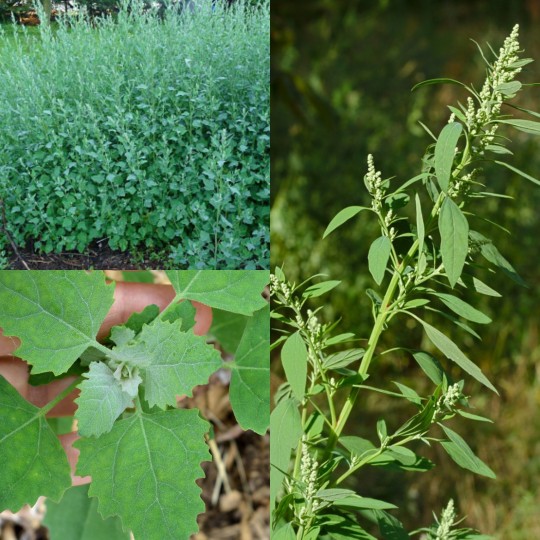
Find:cultivated fields, pastures, wasteland, roadsides, gardens and almost anywhere the soil is disturbed.
Description:Leaves are alternate, 1 to 4 inches long, up to about 2½ inches wide, variable in shape, diamond-shaped to egg-shaped to lance-elliptic in outline, pointed to blunt at the tip, wedge-shaped at the base, tapering to a stalk half to about as long as the blade. Lower leaves are largest, usually irregularly toothed, 1½ to 2+ times as long as wide, occasionally with a pair of very shallow lobes near the base (but usually not), becoming smaller and less toothy as they ascend the stem with the uppermost leaves often much narrower, proportionately longer, and toothless.Surfaces are green often turning reddish with age, hairless, moderately to densely white or pink-mealy especially when young, the upper surface usually becoming smooth, the lower surface usually remaining white-mealy. Stems are erect to ascending, unbranched to much branched, sparsely to densely white-mealy especially on the upper stem, and green to purple striped, sometimes purple at the leaf nodes.
Precautions:lambs quarters contain oxalic acid, which can be both a stomach irritant and can impede the absorption of calcium. Cooking eliminates most oxalic acid — but go easy if you choose to eat them raw.
Lilacs
(Not native but everywhere)
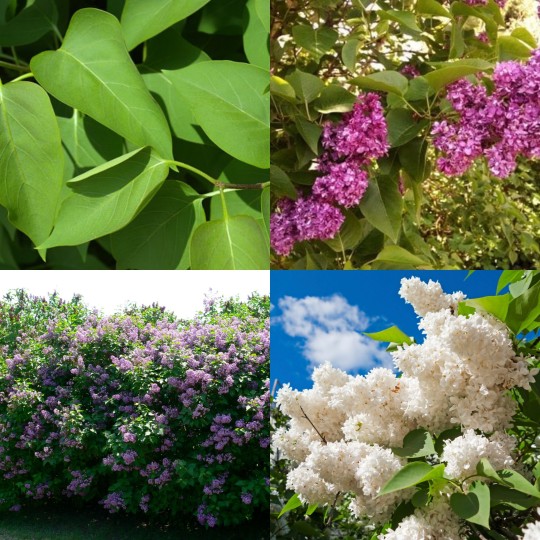
Find: yards,farms,feild and parks.
Description:This shrub is 8-20' tall, sending up multiple branching stems that form a vase-shaped crown. Stems at the base of this shrub are up to 8" across. The bark of large old stems is gray to gray-brown, somewhat rough-textured, slightly shredded, and sometimes shallowly furrowed. The bark of young stems is gray to brown and smooth, while new shoots are green and glabrous. Pairs of opposite leaves occur along the young stems and shoots. Individual leaves are 2-5" long and 1½-3½" across; they are cordate to ovate and smooth along their margins. The upper leaf surface is yellowish green to dark green and hairless, while the lower surface is pale green and hairless. The slender petioles are ½-1½" long, light green, and glabrous. Elongated panicles of flowers about 3-7" long develop from the stems of the preceding year. The panicles taper gradually toward their apices and they are ascending to erect. Individual flowers are about 1/4" (6 mm.) across and 1/3" (8 mm.) long, consisting of a narrowly tubular corolla with 4 spreading lobes, a short tubular calyx with 4 teeth, a pistil with a single style, and 2 inserted stamens. On different shrubs, the corollas can be purple, lavender, light blue, pink, or white, although lavender is the most common color. The branches of each panicle are light green and glabrous.
Edible Parts and uses:lilac blossoms are edible.Make into syrups,teas and wines.
Precautions:no real precautions.
Mallow-High
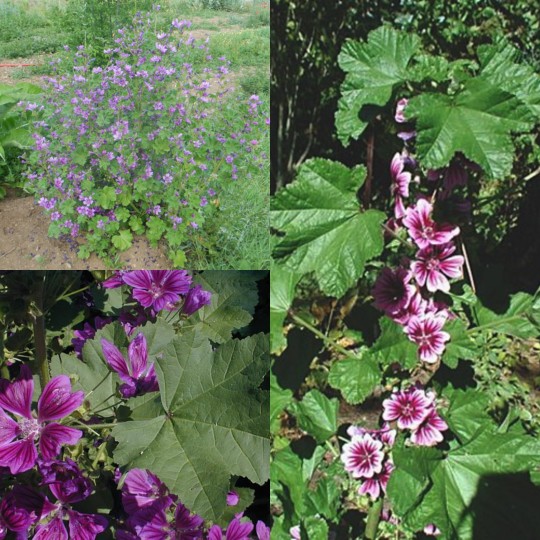
Find:grows in meadows, roadsides, disturbed sites and gardens.
Description:The flowers are funnel shaped or cup shaped, and usually pale pink, with each bloom having the five separate petals typical of all mallow varieties. It grows at least a metre and a half in height, is well branched.
Edible Parts and uses:leaves are edible raw.young leaves are more tender and less bitter than older leaves.young shoots are edible raw.leaves are suitable as a soup thickener.seeds are edible raw.seeds have a palatable, nut-like flavour.flower buds and flowers are edible.fruits are edible.
Precautions:Poisoning is caused by ingestion of high doses of nitrates (muscle weakness, nausea, vomiting, lack of coordination).
Mallow-Musk
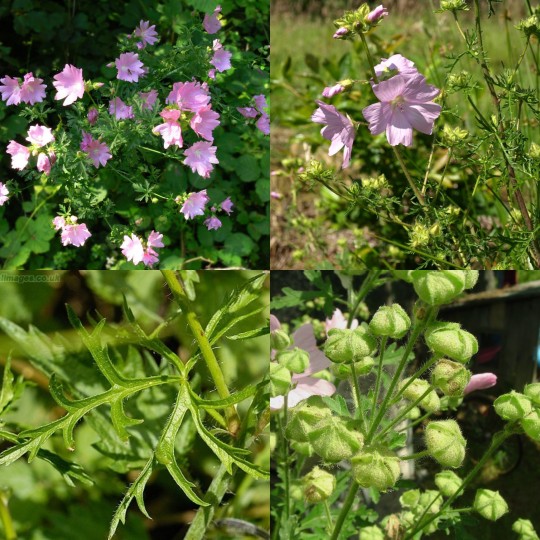
Find:grows in meadows, roadsides, disturbed sites and gardens.
Description: is an ephemeral woody perennial. It has leaves of 5 to 10 cm whose musky odor has given its name to the plant. The upper leaves are pennatized - meaning finely cut. The flowers appear from June to October, in the shape of a flattened cup, with five petals, white or very pale pink.
Edible Parts and uses:leaves are edible raw.young leaves are more tender and less bitter than older leaves.young shoots are edible raw.leaves are suitable as a soup thickener.seeds are edible raw.seeds have a palatable, nut-like flavour.flower buds and flowers are edible.fruits are edible.
Precautions:Poisoning is caused by ingestion of high doses of nitrates (muscle weakness, nausea, vomiting, lack of coordination).
Common Milkweed

Find:fence rows, on roadsides, in fields, and in prairies and pastures.
Description:This is a tall and conspicuous species that sometimes forms large clones. The umbels bear large balls of pink to purplish flowers that have an attractive odor.Follicles split open in the fall and early winter dispensing wind borne seeds.
Edible Parts and uses:Although milkweeds are poisonous raw, the young shoots, leaves and seed pods are all edible cooked.
Precautions: Poisonous parts include milky sap from leaves, stems. Toxic only in large quantities. Symptoms include vomiting, stupor, weakness, spasms by ingesting other species; need careful identification.
Mint
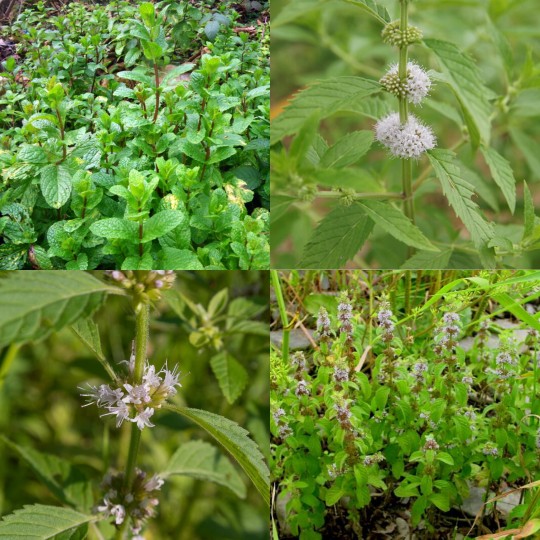
Find:found in shaded areas, especially in moist soils, however their wide spreading rhizomes can collect moisture from a wide area. along rivers, lakes and streams, as well as shaded areas along the edges of forest and woodland.
Description:leaves and stems are generally hairy but these fine hairs can sometimes be absent. The leaves are elliptic, toothed and deeply veined. The flowers are arranged on spikes, filled with clusters of white, pink or purple petals.
Edible Parts and uses: leaves and stems.
Precautions:no real precautions.
Mullein
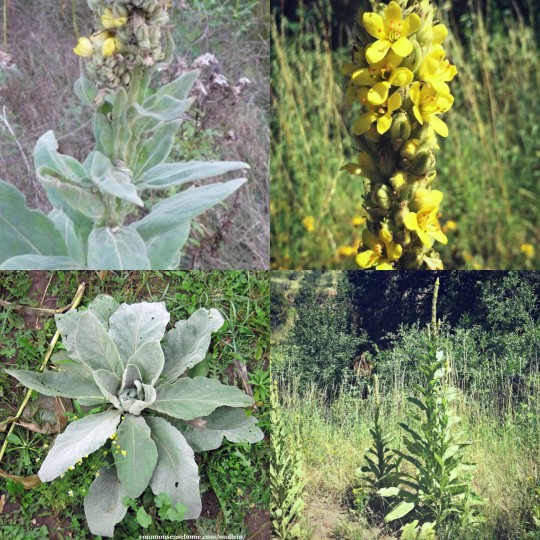
Find:Generally on open ground in disturbed soil.
Description:Biennial up to 2 m tall. Large pale green-grey, woolly, oval or eliptical leaves with winged stalks arranged in a basal rosette in first year. Flower spike in second year ends in a densely packed terminal spike occasionally with smaller side spikes. Flowers yellow with 5 petals. Fruit is oval capsule.
Edible Parts and uses:leaves and flowers are edible, enjoying a cup of tea made from these parts is generally preferable. Leaves and flowers can be used in a salad.
Precautions:The root, seeds and, to a lesser extent, the leaves of the plant, contain poisonous components.
Narrow-leaved purple coneflower
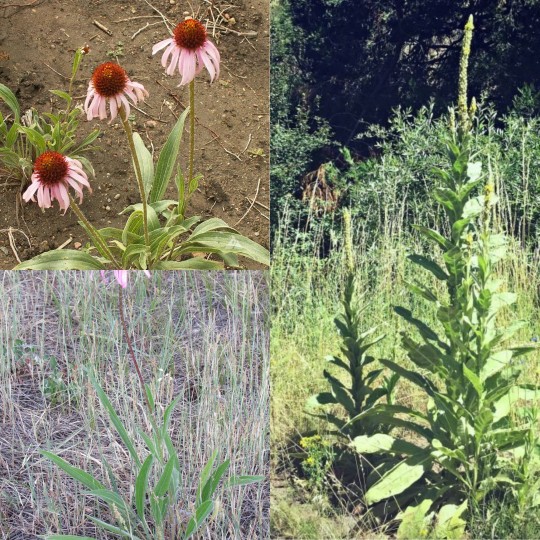
Find:is found in mixed grass prairies.
Description:Leaves are mostly basal, with stem leaves widely spaced and alternately attached on the lower half of the stem. Lower leaves are long and narrow, to 8 inches long, ½ to 1 inch wide, on long stalks, becoming smaller and stalkless as they ascend the stem. Edges are toothless and there are 3 distinct veins along the length. Stems and leaves are hairy and rough to the touch. Stems may be green or purple tinged.
Edible Parts and uses:Leaves and flower petals are edible. All parts of the plant have been used in tinctures or other medicinal methods.
Precautions:no real precautions.
Johnny jump-ups
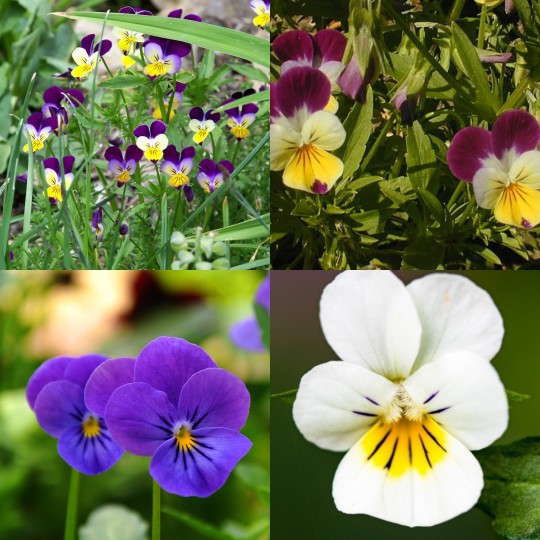
Find:Habitats include limestone glades, moist sand prairies, fields, edges of sandy paths, and waste places. Sandy areas with a history of disturbance are preferred.
Description:This wildflower is a winter or spring annual about 6" tall, sometimes branching near the base of the plant; it is more or less erect. The small basal leaves have orbicular blades with long slender petioles; these are followed by alternate leaves along the stems. The stems are lightgreen to purplish green and hairless.
Edible Parts and uses:flower petals.
Precautions:no real precautions.
Pearly Everlasting
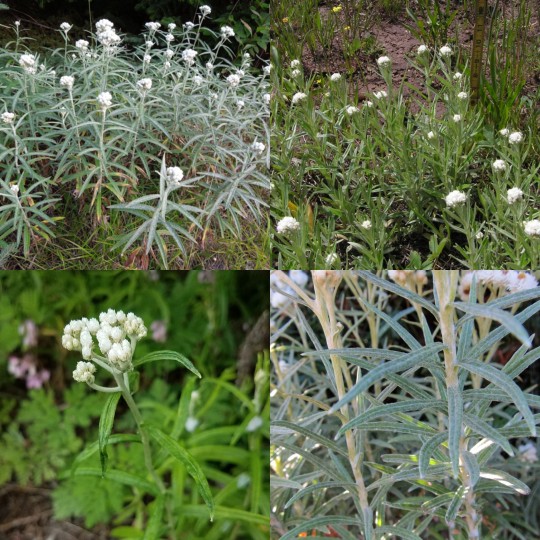
Find:growing in sunny locations althoughtit can be found in part shady areas as well. It likes dry fields, along roadsides, disturbed soils, and the edges of wooded areas.
Description:This plant is easily recognizable; it has small white button-like flowers with yellow centres. It forms a bushy mound of hairy silver-gray foliage but the flowers are easy to identify. One salient feature is that the undersides of the leaves are covered in tiny hairs, giving them a woolly feel and appearance. The stems are dry and brittle.Pearly everlasting flowers are generally flat-topped clusters of numerous 0.5cm to 1cm (¼ to 1/3”) flower heads at the top of the plant.
Edible Parts and uses:flowers in tea.Young leaves are edible when cooked.
Precautions:no real precautions.
#lambs quarter#lilacs#Mallow#musk mallow#common Milkweed#Milkweed#mint#herbs#mullein#coneflower#Johnny jump up#pearly Everlasting#foraging#cottagecore#homesteading#plants
23 notes
·
View notes